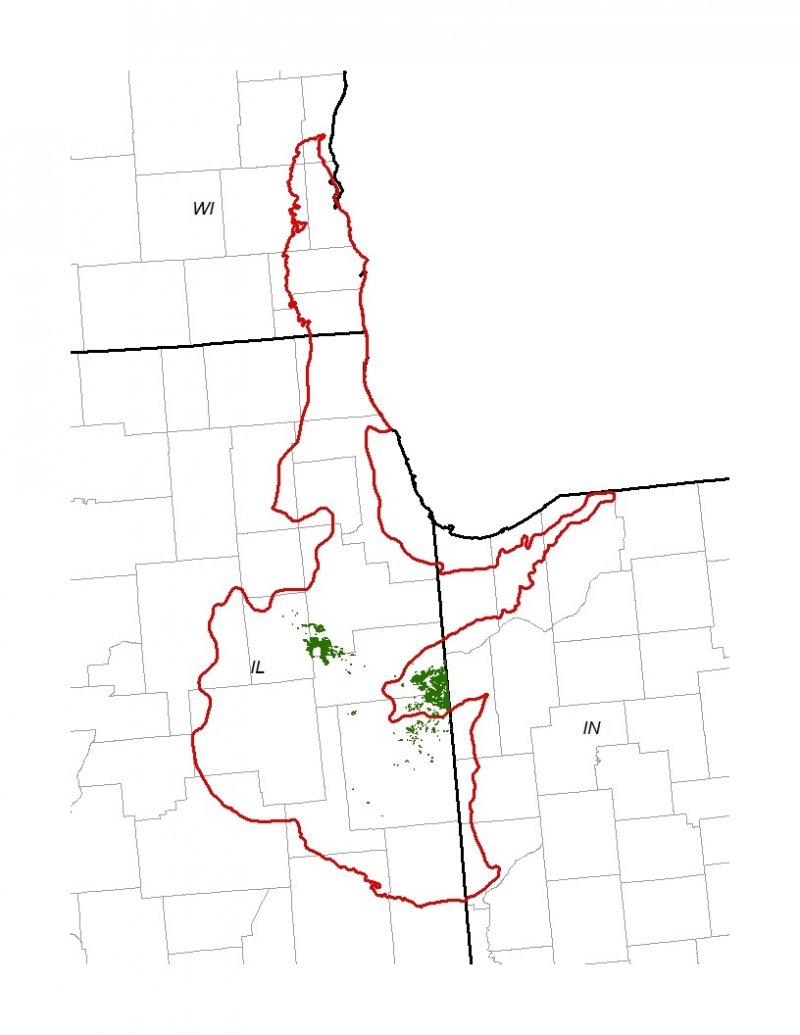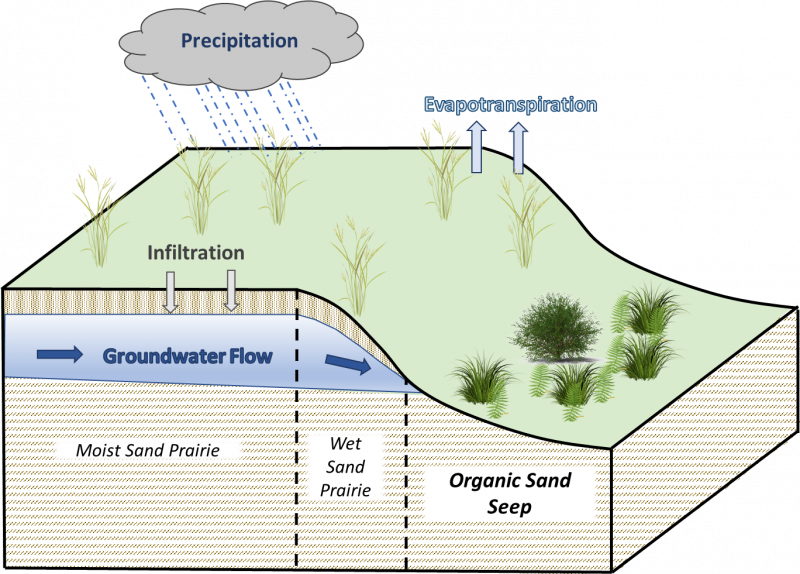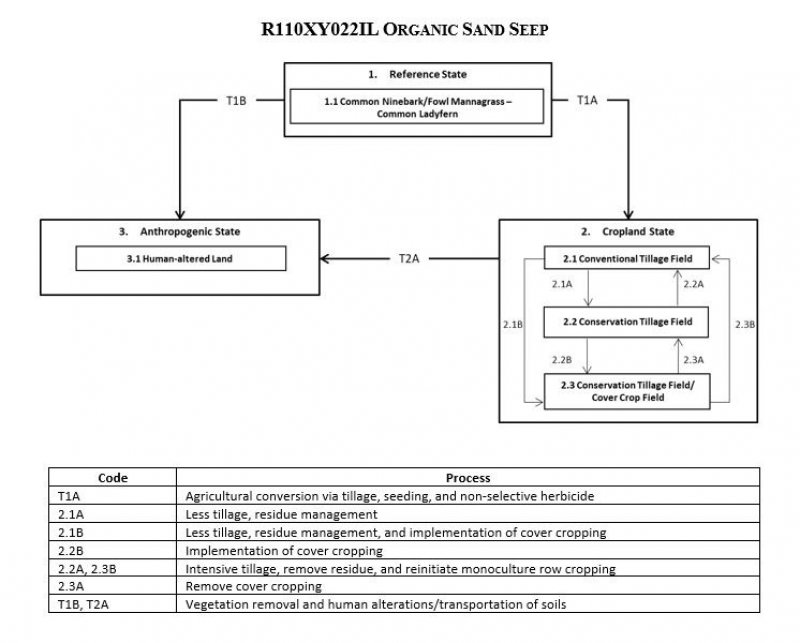
Natural Resources
Conservation Service
Ecological site R110XY022IL
Organic Sand Seep
Last updated: 4/22/2020
Accessed: 04/02/2025
General information
Provisional. A provisional ecological site description has undergone quality control and quality assurance review. It contains a working state and transition model and enough information to identify the ecological site.
MLRA notes
Major Land Resource Area (MLRA): 110X–Northern Illinois and Indiana Heavy Till Plain
The Northern Illinois and Indiana Heavy Till Plain (MLRA 110) encompasses the Northeastern Morainal, Grand Prairie, and Southern Lake Michigan Coastal landscapes (Schwegman et al. 1973, WDNR 2015). It spans three states – Illinois (79 percent), Indiana (10 percent), and Wisconsin (11 percent) – comprising about 7,535 square miles (Figure 1). The elevation is about 650 feet above sea level (ASL) and increases gradually from Lake Michigan south. Local relief varies from 10 to 25 feet. Silurian age fractured dolomite and limestone bedrock underlie the region. Glacial drift covers the surface area of the MLRA, and till, outwash, lacustrine deposits, loess or other silty material, and organic deposits are common (USDA-NRCS 2006).
The vegetation in the MLRA has undergone drastic changes over time. At the end of the last glacial episode – the Wisconsinan glaciation – the evolution of vegetation began with the development of tundra habitats, followed by a phase of spruce and fir forests, and eventually spruce-pine forests. Not until approximately 9,000 years ago did the climate undergo a warming trend which prompted the development of deciduous forests dominated by oak and hickory. As the climate continued to warm and dry, prairies began to develop approximately 8,300 years ago. Another shift in climate that resulted in an increase in moisture prompted the emergence of savanna-like habitats from 8,000 to 5,000 years before present (Taft et al. 2009). Forests maintained footholds on steep valley sides, morainal ridges, and wet floodplains. Fire, droughts, and grazing by native mammals helped to maintain the prairies and savannas until the arrival of European settlers, and the forests were maintained by droughts, wind, lightning, and occasional fire (Taft et al. 2009; NatureServe 2018).
Classification relationships
USFS Subregions: Southwestern Great Lakes Morainal (222K) and Central Till Plains and Grand Prairies (251D) Sections; Kenosha-Lake Michigan Plain and Moraines (222Kg), Valparaiso Moraine (Kj), and Eastern Grand Prairie (251Dd) Subsections (Cleland et al. 2007)
U.S. EPA Level IV Ecoregion: Kettle Moraines (53b), Illinois/Indiana Prairies (54a), and Valparaiso-Wheaton Morainal Complex (54f) (USEPA 2013)
Illinois Natural Areas Inventory: Sand Seep (White and Madany 1978)
Ecological site concept
Organic Sand Seeps are located within the green areas on the map. They occur on depressions on outwash plains. The soils are Histosols that are very poorly drained and very deep, formed in organic material over sandy outwash or glaciolacustrine deposits.
The historic pre-European settlement vegetation on this ecological site was dominated by hydrophytic woody and herbaceous vegetation. Fowl mannagrass (Glyceria striata (Lam.) Hitchc.) and common ladyfern (Athyrium filix-femina (L.) Roth) are characteristic herbaceous species of the site, and common ninebark (Physocarpus opulifolius (L.) Maxim., orth.cons.) is a characteristic shrub. Species indicative of an undisturbed plant community associated with this ecological site include cinnamon fern (Osmunda cinnamomea L.), royal fern (Osmunda regalis L.), and spinulosa woodfern (Dryopteris carthusiana (Vill.) H.P. Fuchs) (White and Madany 1978; Taft et al. 1997). Acidic groundwater seepage flowing through sand is the primary disturbance factor that maintains this site, while drought and fire are secondary disturbances.
Associated sites
| R110XY015IL |
Wet Sand Prairie Outwash parent material that is shallow to a high-water table including Fieldon, Gilford, Granby, Granby variant, Hooppole, and Mussey soils |
|---|
Similar sites
| R110XY023IL |
Organic Interdunal Fen Organic Intertidal Fens are a similar vegetation type, but the site is a LACUSTRINE FRINGE wetland |
|---|
Table 1. Dominant plant species
| Tree |
Not specified |
|---|---|
| Shrub |
(1) Physocarpus opulifolius |
| Herbaceous |
(1) Glyceria striata |
Click on box and path labels to scroll to the respective text.



